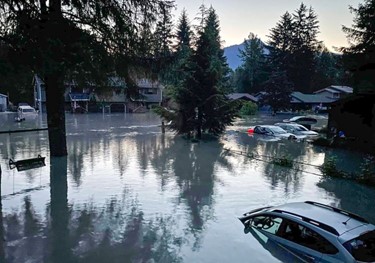
Residents in Alaska's Capital Grapple with Flood After Ice Dam Breaks
Following the rupture of an ice dam, residents in Alaska's capital city are left dealing with the aftermath as they clean up waterlogged homes. The flood was triggered by the retreat of a smaller glacier near the Mendenhall Glacier, which left behind a basin that occasionally releases water beneath or around the glacial ice dam.
On Wednesday, Debbie Penrose Fischer, standing in her yard under the hot sun, tried to salvage a soaked cookbook that held sentimental value, though she wasn't hopeful. Friends nearby helped her move boxes from her garage, which was submerged earlier this week when the lake dammed by the Mendenhall Glacier burst, flooding neighborhoods that had never faced such a threat before. "We're fortunate," Fischer remarked. "No one was injured. I've lost many things I cherish, which is tough, but they're just things."
Initial estimates suggest that around 100 homes and several businesses were damaged by the rapidly rising waters, which peaked around 3:15 a.m. on Tuesday. In some areas, vehicles were seen floating as residents rushed to evacuate. Fischer's daughter, Alyssa, who lives nearby, mentioned that at one point, the water in the street was up to her hips.
By Tuesday, the waters began to recede, and by Wednesday afternoon, levels had returned to the typical range for this time of year, according to the National Weather Service.
The flooding occurs due to the retreat of a smaller glacier near the Mendenhall Glacier, a result of warming temperatures. This retreat leaves behind a basin that fills with rainwater and snowmelt in the spring and summer. When the pressure builds up, the water forces its way beneath or around the ice dam created by the Mendenhall Glacier, eventually flowing into Mendenhall Lake and the Mendenhall River, as it did this week.
Since 2011, this phenomenon has occasionally caused flooding in areas near the lake and river. Last year, floodwaters eroded large sections of the riverbank, damaged homes, and even swept one residence into the river. However, the scale of this week's flooding was unprecedented, leaving residents shocked as they worked to dry out furniture, books, and other belongings in the warm, sunny weather. On Wednesday, the curbs were lined with piles of trash bags and other debris, including wood, boxes, soaked insulation, and carpeting. A street sweeper worked to clean up the gray, silty residue left behind by the receding waters.
Although the basin was formed by glacial retreat, Eran Hood, a professor of environmental science at the University of Alaska Southeast who has studied the Mendenhall Glacier for years, noted that climate change has little influence on the year-to-year variations in the flooding volume in Juneau. "It's clear that these floods will continue for some time, likely on a decadal scale," he said. "But various competing factors make it challenging to predict the size of future floods without more detailed modeling of the glacier's dynamics." Eventually, the Mendenhall Glacier will retreat and thin enough that it can no longer act as a dam, Hood added.
This flooding serves as a reminder of the global threat posed by the bursting of snow-and-ice dams, a phenomenon known as a jökulhlaup, which is relatively unknown in the U.S. but could endanger around 15 million people worldwide.
Juneau, a city with approximately 30,000 residents in southeastern Alaska, is only accessible by plane or boat. With tourist season in full swing, the city is already facing a housing shortage, which could limit temporary accommodations for flood victims. Additionally, Juneau has a limited number of rental car agencies for those whose vehicles were submerged.
The Mendenhall River reached a new record crest of 15.99 feet (4.9 meters), surpassing last year's flood level by about a foot, with water reaching further into the Mendenhall Valley, officials reported. Some homes outside the expected flood areas were affected. The valley is located approximately a 15 to 20-minute drive from downtown Juneau.
Alyssa Fischer recounted that when she went to bed on Monday night, she didn't anticipate flooding in her area. Her father woke her up hours later via FaceTime to warn her about the rising waters. She quickly moved her cars to higher ground, as well as her quails, before evacuating with her children, ages 4 and 8, and pets to a shelter at a local school. She later noticed that the license plate on her truck had been bent by the force of the water.
By Wednesday, she was relieved that the damage to her property was mostly confined to a crawl space and the garage. She had spread out boxes, rugs, and other items in her yard and had a fan running to dry out the garage.
However, she remains concerned about the future. When she bought the house earlier this year, its location away from the river was a major selling point. After returning home on Tuesday, her 8-year-old daughter asked when the floodwaters would return. "I'm sure I'll be stressed out next year around this time," she said, expressing a desire for community meetings to address future flood risks.